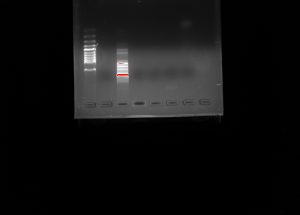Lab 11: Electrophoresis 3/29/18
Purpose
The purpose of this lab was to perform the gel electrophoresis on the reactions made from the Chelex or Power Soil protocol created the lab prior. Once the electrophoresis was completed, we were to determine whether any significant amount of DNA was isolated or amplified from the eDNA.
1. Remove the rubber bumpers from the gel tray
2. Place the gel tray inside the electrophoresis power box
3. Pour 1X TAE solution into the power box
A. Do this until a thin layer of the solution covers the top of the gel, making sure the solution flows continuously to the other side
4. Place the 6 prepared reactions into the gel well using the micropipette
A. Fill the wells starting from the left side with the positive end facing away from yourself
B. Record which reaction is in each well
5. Run the gel electrophoresis for 30 or more minutes at 100 volts
6. After the electrophoresis is complete, remove the gel containing the reactions
A. You should be able to see the reactions run from the negative to the positive end of the power box
7. Bring the post electrophoresis gel to Dr. Adair to check the results using UV light of the eDNA
8. Record any results
Data and Observations
• No eDNA reactions containing V4 or COX1 primers showed any signs of amplified or isolated DNA
• Only the ladder and positive control (containing Paramecium DNA and COX1 primers) showed any DNA
• Other reactions had no success in producing amplified/ isolated DNA
Loaded Samples from left to right
Well 1: Ladder
Well 2: COX1 Negative Control
Well 3: COX1 Positive Contro
Well 4: COX1 eDNA
Well 5: V4 Negative Control
Well 6: V4 Positive Control Well 7: V4 eDNA
Conclusion and Future Steps
In all honesty, the results of this lab proved to be disappointing. Our group used the Powersoil protocol to isolate the DNA for the reactions. Although we thought it would be successful, the results proved otherwise. Only the ladder and positive control with the Paramecium DNA and COX1 primers had results of amplified DNA. Those were successful, but our main focus was to get the DNA from our own soil ciliate sample to be amplified. There are many possible sources of error throughout the past few labs. A main source of error could be connected to the primers. With the semester almost ending, there is not much our group can do in terms of future steps for these protocols. However, we will continue to examine our sources of error and analyze the performed protocols to see which materials we should continue using in order to hopefully amplify the DNA sequences and analyze them. Overall, our efforts throughout these labs contribute positively to the scientific community due to our failed amplifications. Failure is a source for learning and improvement, and hopefully scientists in the future will be able to use our efforts to improve future protocols.

